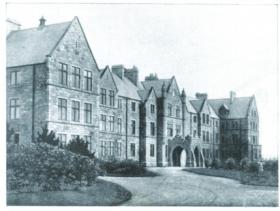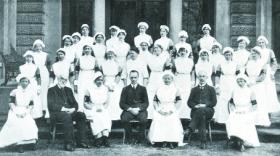The other women of 1916
Published in 20th Century Social Perspectives, 20th-century / Contemporary History, Issue 5 (Sep/Oct 2006), News, Revolutionary Period 1912-23, Volume 14
Irish counties auxiliary war hospital, Glasnevin, now the Ministry of Defence.
In October 1914, two months after the outbreak of the Great War, the civilian voluntary effort to support Irish troops at home and at the front was coordinated for the provinces of Leinster, Munster and Connacht by a joint executive committee of people from the British Red Cross Society (Co. Dublin branch) and the Irish district of the St John’s Ambulance Association. Ulster’s voluntary committee decided to operate separately and volunteers there took their instructions from the Belfast branch of the British Red Cross Society. Before the war, a network of voluntary aid units had been set up in Ulster in expectation of civil war if Home Rule was imposed.
Voluntary aid groups or detachments (VADs) of men and women were raised on a county-by-county basis. After enrolling as a VAD, men and women had to undertake and pass a course in first aid. Women were taught home nursing and received tuition in hygiene and cooking. They also practised in hospital wards as nurse’s aids.
With the massive numbers of war casualties coming to Ireland, the demand for hospitals grew. Throughout the years of the war, the joint committee, based at 51 Dawson Street, Dublin, was responsible for organising and equipping 23 auxiliary hospitals and nursing homes spread throughout Leinster, Munster and Connacht. In most instances, local committees were appointed to raise money through voluntary contributions to equip and manage these hospitals. Many of the male and female volunteers worked in the auxiliary hospitals as ambulance personnel and nurse’s aids. Trained nurses were deemed too valuable to waste, so much of the menial and routine hospital work was carried out by the women VADs. One such volunteer described her work:
‘Long hours, much scrubbing and carrying of meals, being at the beck and call of an uncertain-tempered staff nurse and other menial work, with plentiful blame for what they had not done, combined to make their sacrifice a very real one’.

A group of Kingstown VADs. Violet Barrett is among this group.
Not all VAD service involved working as ambulance personnel or as nurse’s aids in hospitals. Red Cross workrooms were set up in 64 Merrion Square, Dublin. The work the women carried out here was mainly the cutting and making of garments such as pyjamas, pants and vests for soldiers at home and at the front. Some 300 women volunteers worked long hours and produced approximately 50,000 garments, along with over 20,000 pairs of socks and 10,000 mufflers. Regular appeals were made for supplies of ‘necessaries and comforts to the troops at the front and various field, base and general hospitals in France’. Special appeals were made for items such as nightshirts that were urgently needed. The appeal notice requested that all socks and grey shirts should be washed before being sent to the depot at 51 Dawson Street. Bagfuls of dirty linen with smelly socks were not appreciated by the ladies at the clothing depot!
In December 1916 an Irish war hospitals supply depot was set up in 40 Merrion Square, Dublin. Here volunteer women made dressings and bandages, such as papier mâché surgical applications and sphagnum moss dressings. Owing to the war, one of the first articles to become scarce was cotton wool. Sphagnum moss proved a good substitute because of its excellent absorption properties. Some women spent many a cold winter’s afternoon gathering moss from bogs in the Dublin Mountains. The moss was sterilised, dried and sent to sub-depots throughout Ireland. The central depot for sphagnum moss collection in Dublin was the Royal College of Science in Merrion Street (now the Department of An Taoiseach).
To save some money on the cost of stamps, women volunteered to deliver letters and circulars from the various war societies. Many of the Irish regiments, such as the Royal Dublin Fusiliers, the Royal Munster Fusiliers, the Leinster Regiment and the Connaught Rangers, had volunteer societies who set up committees to organise comforts for the troops in their respective recruiting areas. The Royal Irish Fusiliers looked for ‘discarded razors, shaving brushes, strops and warm waistcoats’, which were to be sent to an address in Armagh. Mrs Allen, of the United Irishwomen at 20 Lincoln Place, Dublin, collected for the 10th Cycling Company, stationed at the Curragh. A bureau was set up at 45 Kildare Street to accept donations of ‘cigarettes, pipe-tobacco, matches and chocolate for the various battalions of the Dublin Fusiliers serving at the front’. The office was mainly run by women. In August 1914 a committee of the Dublin Women’s Unionist Club held a meeting at its offices at 10 Leinster Street, Dublin. Following this meeting, the unionist ladies of Dublin decided to work for the men serving with the Dublin Fusiliers through ‘the collection and dispatch of a large quantity of newspapers, magazines and books to the battalions of the regiment serving with the Expeditionary Force in France and Flanders’. Apparently the ladies thought that the intellectual needs of the men were more important than their physical needs. The women of the Dublin Unionist Club were not the only members of the fairer sex who worked for the Irish men in the trenches. During the war, at their north County Dublin convent in Baldoyle, the Irish Sisters of Charity took to making shirts for the British Army. There was nothing charitable about this work, however, as it was strictly business. At the end of the war, when there was no more need for army shirts, the nuns turned their skills to crochet work, knitwear and the manufacture of silk garments.
The majority of the young ladies who volunteered for service were in their late teens to mid-twenties. Some of them, like Mary Martin and Rosemary Savage, served near the front. Others, like Monica Roberts, served their cause at home. Mary Martin (featured in the last, Africa, issue of HI) served as a VAD in Malta, where she tended many of the Gallipoli wounded. Before she left for a field hospital in France, Rosemary Savage lived in Cushendall, Co. Antrim, where she and her mother ran fund-raising events in aid of the comfort fund for the 13th Royal Irish Rifles. Monica Roberts and her friend used to go round the parish halls of south County Dublin performing singing recitals and gathering money to buy sweets, cigarettes and gloves to send as comfort parcels to the Dublin Fusiliers in France. She wrote to many of the men, some of whom were her own age. In their loneliness, some of the younger soldiers adopted Monica as their sweetheart. (Her letters are in the archive of the Royal Dublin Fusiliers Association in Dublin City Archive and Library at Pearse Street, Dublin.) Sophia Violet Barrett was born in Ballintava, Co. Galway. She joined the Carrickmines and Kingstown branch of the VADs and volunteered for service in Rouen and Abbeyville in France.
By the end of the war, from the Irish branches of the British Red Cross Society and the St John’s Ambulance Brigade, 83 women’s VAD units, consisting of 2,927 members, had been established throughout the three provinces of Leinster, Munster and Connacht, the majority being in Dublin. Moreover, the volunteer women workers in the Irish (Leinster, Munster and Connacht) war hospital supply depot numbered approximately 6,000. By the end of May 1914 the Ulster VADs had 3,520 members throughout the province.
Mary Martin returned from the war to set up the Medical Missionaries of Mary. Monica Roberts from Stillorgan married and reared her family on the banks of the Liffey. She died in 1974. Rosemary Savage married an Irish soldier in India and came home to live in Bandon. She died in 1983, having reached the great age of 90. Sophia Violet Barrett was killed while returning to the front from leave aboard the RMS Leinster, torpedoed on 10 October 1918, one month before the war ended.
Tom Burke MBE is chairman of the Royal Dublin Fusiliers Association.
















